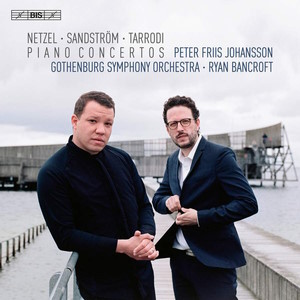
Laura Netzel (1839-1927)
Piano Concerto Op. 84 (1897)
Sven-David Sandström (1942-2019)
Five Pieces for Piano and Orchestra (2017)
Andrea Tarrodi (b. 1981)
Stellar Clouds, Piano Concerto No. 1 (2015)
Peter Friis Johansson (piano)
Gothenburg Symphony Orchestra/Ryan Bancroft
rec. 2021, Gothenburg Concert Hall, Gothenburg, Sweden
BIS BIS-2576 SACD [77]
A red thread underlies this seemingly heterogeneous selection of Swedish works for piano and orchestra. It is Peter Friis Johansson’s commitment to, and championing of, Swedish composers. He has already devoted a BIS release to the music of Helena Munktell. Now, he turns to composers of later generations, two of whom I had not known.
Laura Netzel and her music must be new to many, so a bit of history may be useful. She was born in Rantasalmi in southern Finland but was brought to Stockholm when she was a year old. Being a woman made it quite difficult for her to make her mark on the Swedish musical scene of the time, more so because she was not content to compose songs and short chamber works. Her Swedish Wikipedia page shows an impressive list of works, among them this substantial Piano Concerto. She also had a predilection for French music, often suspicious to the generally German-oriented musical establishment. Critic and fellow composer Wilhelm Peterson-Berger went so far as to dismiss her as one of the “most domineering and French-mad patron saints of the Stockholm musical dilettantes”. Harsh words indeed. To complete the picture, the genesis of the concerto was far from straightforward. It is her largest composition, and she probably realised that the project was a bit too much for all her technical assurance. Clearly the piece was conceived on too wide a scope, so in effect it was never finished, and was never performed in its entirety.
There exist several handwritten versions of the concerto, none of them complete. The third movement ends rather abruptly after some 200 bars, despite the fact that the rest of the work is fully orchestrated. The final movement was performed in Paris and Berlin in a version for two pianos, but there were still doubts about how the conclusion of the work sounded. A number of technical weaknesses had to be put right, and much editing was necessary to produce a playable version. Klas Gagge of the Swedish Musical Heritage undertook this task. The more recent years saw two attempts at completing the concerto. Peter Friis Johansson plays his own reconstruction, in which he lets the work tie itself together cyclically. I think this is justified, since the music of César Franck hovers as a probable influence on much of the thematic material and the orchestration. Laura Netzel’s Piano Concerto remains, for all its weaknesses, a formidable piece of music of some considerable substance. It deserves to be heard, especially when played with such commitment and conviction as here.
The late Sven-David Sandström is much better known, since his music is regularly preformed and recorded. His wide-ranging output includes almost all genres: choral works including settings of the Mass (Freedom Mass and Ordinary Mass and Psalm), orchestral music, some eight concertos to which one might now add Six Pieces for Piano Trio and Orchestra as well as Five Pieces for Piano and Orchestra recorded here, and two large-scale choral-orchestral works (Requiem and High Mass). The Five Pieces were written at the request of Peter Friis Johansson, who also asked for a movement written as a cadenza of sorts that might be played separately. The composer agreed but eventually complied only partially, as I will explain in a while. Even so, the work lives up to its title and may be experienced as a suite of five contrasting movements which display various moods without any real link between them. Måns Tengnér in his informative insert notes writes: “It is as though the soloist […] faced with recurrent opposition seeks to twist dissonances and pain from the hands of a reluctant orchestra. In due course, there is room for increasing bright and diatonic colours, in sounds that constantly seek to rise in ever higher registers”. The work actually concludes high up in the air.
Now, a few words about the independent cadenza. It is to be heard in the third movement but in fact quite briefly, a minute or so. That did not dismay Johansson – “[Sandström] had used his prerogative to act on his own inspiration” – for this movement is full of surprises. It is literally at the heart of the piece. Be that as it may, the suite is a very fine piece of music, full of invention, with many arresting orchestral gestures. It amounts to a most satisfying whole, although some may find it less than the sum of its parts.
The third composer whose piano concerto is recorded here is Andrea Tarrodi, none other than trombonist, conductor and composer Christian Lindberg’s daughter. She also wrote her work for Johansson. The booklet says that her works are often inspired by natural phenomena. Indeed, the title of the fourth movement, Cosmic Nursery, refers to an occurrence when stars explode and stardust is created. Tarrodi’s First Piano Concerto has five movements framed by an introduction and a recapitulation that brings the piece full circle. The central fourth movement is dedicated to Andrea’s daughter Sigrid and to Johansson’s son Philemon. This is the first work by Andrea Tarrodi that I have heard. Her music sounds well written, with a sure sense of the orchestra. I would welcome any opportunity to hear more of it.
In short, this is a fine release, superbly played and recorded, and well up to the label’s standards. I must again mention Måns Tengnér’s notes, on which I have heavily drawn, especially as regards Laura Netzel’s concerto and her work in general. Well worth exploring.
Hubert Culot
Help us financially by purchasing from





















